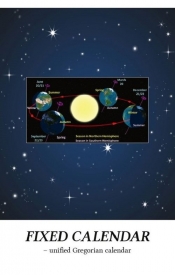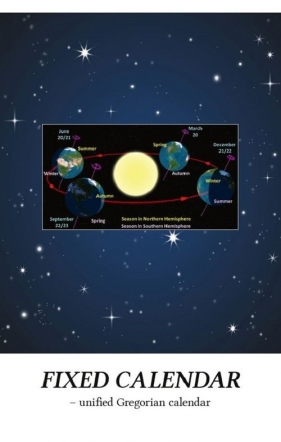12.6
Literatura obcojęzyczna
BookPlan.pl
Fixed Calendar unified Gregorian calendar
Wydawnictwo:
BookPlan.pl
Oprawa: Miękka
12,60 zł
Cena rekomendowana: 15,00 zł

Cena okładkowa/rekomendowana przez wydawcę/producenta.
Wysyłka: 1-3 dni robocze
+ czas dostawy
+ czas dostawy
Opis
The calendar we use today is basically the Julian calendar – introduced in 45 BC by Julius Caesar. In 1582 Pope Gregory XIII made only a minor amendment to this calendar concerning leap years in order to prevent the calendar from lagging behind the solar year by 1 day in every 128 years – minimising this error to 1 day in every 3322 years. When it was first created, there were only two versions of the Julian calendar. Th e first was the ordinary year calendar and the second wasthe leap year calendar. Th e division of the calendar into weeks increased the number of versions from two to fourteen, and the introduction of a moveable Easter meant that since 325 AD we have been using a calendar in as many as 490 versions – each year the calendar brings us a different arrangement of weeks and holidays, a different number of working and non-working days.
Th e industrial age created the need for sorting out the excessive diversity prevailing in many areas. A new fi eld was developed – standardisation – which includes, among other things, unification, that is reducing issues to a single form or standard.
In 1834, Marco Mastrofi ni (1763-1845), an Italian priest, philosopher and mathematician, proposed the unification of the calendar and the introduction of a fixed calendar.
Half a century later, the French Astronomical Society organised a special competition to create a new, fixed calendar. A number of other proposals were also put forward before World War One. Enthusiasts of reforming the calendar managed to get the International Congress of Chambers of Commerce to pass a resolution in support of the reform, while the Swiss government pledged to take appropriate diplomatic action.
In the turbulent 20th century, the issue of calendar reform was not forgotten – just postponed until calmer times. We are now in the third decade of the 21st century and there is nothing to suggest that calmer times are ever to come. It is high time to seriously address the issue of introducing a fixed calendar – theunifi ed Gregorian calendar.
Th e industrial age created the need for sorting out the excessive diversity prevailing in many areas. A new fi eld was developed – standardisation – which includes, among other things, unification, that is reducing issues to a single form or standard.
In 1834, Marco Mastrofi ni (1763-1845), an Italian priest, philosopher and mathematician, proposed the unification of the calendar and the introduction of a fixed calendar.
Half a century later, the French Astronomical Society organised a special competition to create a new, fixed calendar. A number of other proposals were also put forward before World War One. Enthusiasts of reforming the calendar managed to get the International Congress of Chambers of Commerce to pass a resolution in support of the reform, while the Swiss government pledged to take appropriate diplomatic action.
In the turbulent 20th century, the issue of calendar reform was not forgotten – just postponed until calmer times. We are now in the third decade of the 21st century and there is nothing to suggest that calmer times are ever to come. It is high time to seriously address the issue of introducing a fixed calendar – theunifi ed Gregorian calendar.
Szczegóły
Tytuł
Fixed Calendar unified Gregorian calendar
Wydawnictwo
Rok wydania
2024
Oprawa
Miękka
Ilość stron
28
Format
14.3 x 20.5 cm
Języki
angielski
ISBN
9788396600745
Język oryginału
polski
Rodzaj
Książka
EAN
9788396600745
Kraj produkcji
PL
Producent
BOOKPLAN.PL Joanna Zimny

Dodałeś produkt do koszyka

Fixed Calendar unified Gregorian calendar
12,60 zł

Recenzje